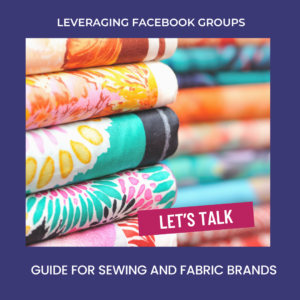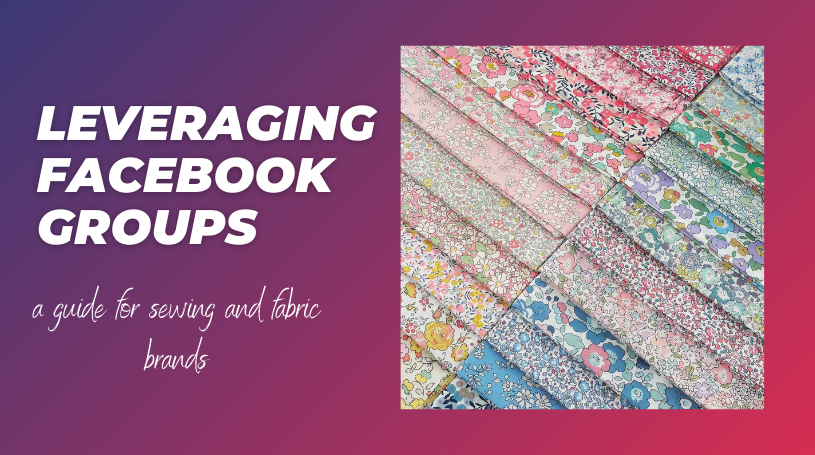In today’s digital age, building a community around your brand is more crucial than ever. For sewing related companies, creating a Facebook Group can be a powerful way to foster customer engagement, generate user-generated content (UGC), and build a loyal customer base. This blog will explore the benefits of a brand-centric Facebook Group and provide strategies to create and manage one effectively.
Introduction to Facebook Groups
A Facebook Group is a dedicated space on the platform where users can engage, share content, and discuss topics of common interest. For fabric companies, it serves as a hub for customers to share their projects, seek advice, and interact directly with the brand and other sewing enthusiasts.
Benefits of a Brand-Centric Facebook Group
Enhanced Customer Engagement
Facebook Groups allow direct interaction with customers, facilitating real-time feedback and discussions. This engagement helps build stronger relationships with your audience.
Community Building
A Facebook Group fosters a sense of belonging and loyalty among members. It creates a supportive environment where customers can share ideas, experiences, and showcase their projects.
Cost-Effective Content Creation
Users generate content by sharing their projects, tips, and reviews, reducing the need for extensive content creation by the brand. This UGC is authentic and often more relatable to other customers.
Valuable Insights
A Facebook Group provides valuable insights into customer preferences and trends. Brands can collect feedback to improve products and services, ensuring they meet customer needs.
Strategies for Creating and Managing a Facebook Group
Establish Clear Guidelines
Set rules for posting, commenting, and group behavior to ensure a positive and respectful environment. Clear guidelines help maintain the quality and focus of the discussions.
Regular Engagement
Post regularly to keep the group active and engage with members by responding to comments and questions. Regular interaction helps foster a vibrant community.
Encourage User Participation
Prompt members to share their sewing projects and experiences. Organize challenges and contests exclusive to group members to encourage participation.
Feature User Content
Highlight outstanding projects and useful tips shared by members. Create albums or pinned posts featuring top contributions, showcasing the creativity and talent within the community.
Provide Value
Share exclusive content such as tutorials, patterns, and discounts. Offer early access to new products or special promotions to group members, making them feel valued and special.
Examples of Successful Facebook Group Activities
Monthly Sewing Challenges
Encourage members to post their projects based on a monthly theme. Recognize winners with small prizes or features, promoting friendly competition and creativity.
Project Showcases
Regularly highlight member projects, encouraging others to participate and share their work. This not only boosts engagement but also inspires other members.
Live Q&A Sessions
Host live sessions with experts or influencers to answer member questions. These sessions provide valuable insights and keep the community engaged.
Polls and Surveys
Conduct polls to understand member preferences and interests. Use the insights to tailor content and offerings to better meet the needs of your community.
Collaborative Projects
Organize group-wide projects such as community quilts or fabric swaps. These collaborative efforts build camaraderie and a deeper sense of community.
Conclusion: Harnessing the Power of Community
Creating a Facebook Group around your brand not only fosters a strong community but also generates a wealth of user-generated content. It’s an effective strategy to enhance engagement, gain insights, and build lasting customer loyalty. By leveraging the power of community, sewing brands can create a thriving online space that benefits both the brand and its customers.
Visual and Design Tips
When setting up your Facebook Group, consider the following visual and design elements:
- Images: Include screenshots of engaging posts from similar Facebook Groups and visuals of projects shared by members.
- Icons: Use relevant icons for community, engagement, and content sharing to make posts visually appealing.
- Color Scheme: Match the group’s design with your brand’s colors for consistency and brand recognition.
By following these strategies and leveraging the unique benefits of Facebook Groups, fabric companies can create a dynamic and engaged community that drives user-generated content and builds brand loyalty. Start your Facebook Group today and watch your community—and your brand—flourish!


